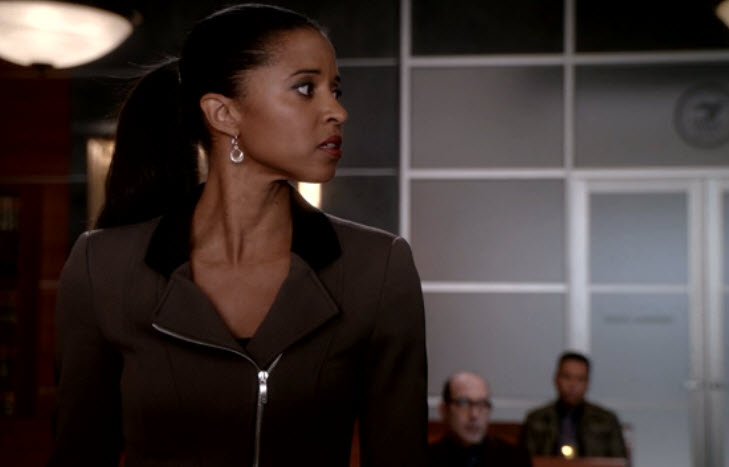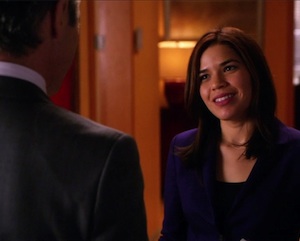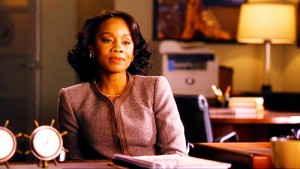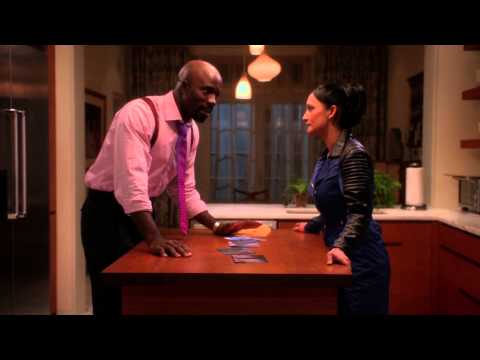We’re now tiptoeing close to the end of The Good Wife — and honestly, television after this point will never be the same again. Showrunners Robert and Michelle King, with help from an incredibly talented stable of performers, have elevated what passes for a solidly good legal drama — raising the bar so high that broadcast networks can’t keep pandering to tried-and-true tropes if they wish to compete with so-called prestige cable dramas.
The series’ finale, which airs on Sunday, May 8, is called “End,” appropriately enough. Yet, in the run-up to “End,” I am filled with regrets, a heap of disappointment, and a truth that not even the sharpest episodes of this drama can dance around: The fact that The Good Wife‘s biggest weakness will always lie in how miserably it failed at portraying characters of color.
In many ways, I’m tired of making this argument over and over again. I’m tired of how an anemic Ferguson-inspired episode is supposed to make us think The Good Wife has any clue as to how to dole out parts equally for all its players. I’m tired that as performers of color have made tremendous inroads into the primetime television arena, landing shows in which they are finally afforded starring roles, complex story arcs, and the opportunity to portray characters who evolve, one of the best-written network dramas lags so far behind.
“The Good Wife‘s biggest weakness will always lie in how miserably it failed at portraying characters of color.”
Yet, this one’s personal for me because Kalinda Sharma, in ways, was the first time I saw myself truly reflected on network television: A queer South Asian character kicking ass. This is not Maulik Pancholy on 30 Rock, but a character with motivations, arcs, and character growth all her own. Archie Panjabi took some of the most banal material on television and transformed it into Emmy-winning gold.
So it was a telling moment when the Kings were quizzed on whether fans could expect Kalinda Sharma to show up for a final cameo before the series finale in May. Co-creator Michelle King’s deliberate response: “Kalinda went off deliberately to disappear — and we’re honoring that choice. It wouldn’t make sense for [Kalinda] to come back.”
Nobody actually ever states, “I have a race-based bias.” People make such feelings known — even if they don’t intend to — through a series of complicated actions. I don’t know if race is at the heart of whatever happened to Kalinda and The Good Wife, but it is difficult to overlook how the drama sidelined one of the strongest performers of their series for two-and-a-half seasons before clumsily writing her off the show.
Also difficult to overlook: How the showrunners deny us a chance for a final adieu to the series’ best character, despite the clamor of fans who have stuck with the show through its peaks and dips, and try to persuade us that even though another lead on the drama — Cary Agos — was smitten by a woman like Kalinda, it makes no sense to bring her back, even for a scene.
For six seasons, Kalinda was the only person of color to be a series regular on The Good Wife — a role now dutifully fulfilled by Cush Jumbo, who, in many ways, steps in to be Kalinda the Remix for Alicia.
“Kalinda went off deliberately to disappear.”
http://cordeliaschase.tumblr.com/post/117551536212/goodbye-kalinda-sharma-well-miss-you
~
Kalinda ex machina was a favorite plot device The Good Wife writers have resorted to when they didn’t know quite how to wrap up a loose end. It’s also probably one of the most offensive executions of the “magical desi” trope. However, The Good Wife‘s diversity problem only starts at Kalinda and goes much further.
There’s even a moment in season six where Kalinda appears in an episode with only six lines — and to ostensibly provide an easy answer to Diane Lockhart’s husband and the firm’s resident ballistics expert Kurt McVeigh. Kurt even asks, “Who is this?” and she plainly responds, “Kalinda,” and we’re left to wonder, is this an inside joke? Are there writers within The Good Wife camp who also understand the poor treatment of an Emmy winner in their ranks is a creative failure?
We joke about Kalinda’s exit, but in many ways, her exit makes a broader statement about the poor treatment of diversity across casting choices on The Good Wife that includes all performers of color.
Self-Referential Commentary Isn’t Change
In the fourth season, there is a moment when Assistant State’s Attorney Geneva Pine and State’s Attorney Peter Florrick sit down for a discussion about racism.

Facing allegations of bias and preferential hiring practices in the middle of a heated campaign for the Illinois Governor’s seat, Florrick asks Pine to sit down and level with him. Is he really a racist? He’s so progressive! He has black friends he met in jail!
But Pine, rightfully, isn’t having any of it. She mentions how Cary Agos was promoted above her or Matan Brody despite being very inexperienced — because Florrick liked his “personality.” She mentions his dismissal of Wendy Scott-Carr (which, The Good Wife, really, y’all couldn’t get Anika Noni Rose in to be a series regular for a couple seasons?)
The scene appears to be a meta criticism for the soap itself: The Good Wife itself has always struggled with diversity, with equal representation, with giving dues to performers of color when they’re owed.
http://foreverinspired.tumblr.com/post/19213266950/thats-right-its-a-bad-economy-for-ideals
In a more recent episode, we experience another meta moment like this: Shortly after they’ve both joined Lockart, Agos, & Lee, both Lucca Quinn and Monica Timmons are awkwardly sequestered into a conference room together by all-white management.
“We think you’ll get along well,” they’re told. They’re encouraged to work together, which prompts Timmons to remark, “Know any Negro spirituals?”
I am never quite sure what to make of shows like this which appear capable of storytelling competency that poke fun at race with one hand, while being complicit with the other.
What’s At Stake?
Late last year, Deadline ran an article that broke down just how pay is meted out among series regulars, recurring guests, special guest stars, and guest stars:
As TV budgets get tighter among viewership fragmentation and declining ratings, studios often limit the number of regular cast members on a show, instead increasingly employing actors as “top of show” recurring guest stars for a fraction of the salary. Meanwhile, guest-starring gigs that would have normally been top of the show are now more and more often done as 1-3-day stints also at a deeply discounted price, making it virtually impossible for actors to live on guest-starring roles and meet their minimums for SAG-AFTRA health insurance.
The Good Wife, at its core, has always been a drama about managing optics: Do the right thing, say the right thing, surround yourself with the right people, go to the right places. It has always been about appealing to a definition of “acceptable” as defined by an imagined critical consensus.
The Kings appear to be among television’s more self-aware and erudite storytellers. Which is why the meta-ness of The Good Wife‘s racial commentary appears especially tone-deaf.
The optics of this series has always placed a premium on whiteness and a specific kind of whiteness above other identities. It is a kind of whiteness that is characterized by wealth, access to education, and liberal politics. In The Good Wife‘s universe, characters who closely fit this mold are the ones rewarded with rich characterization, stories with depth, and screen-time. Characters who deviate from this status quo end up becoming nothing more than scaffolding, devices that simply serve to set Alicia up for one of her come-to-Jesus epiphanies.
“In its seven year run, The Good Wife has never featured more than a single person of color as a series regular.”
It is telling, too, that in its seven year run, The Good Wife has never featured more than a single person of color as a series regular. Overlay that fact with the current economic reality faced by most working actors and this means that for all its lip service to racial equality, this soap has contributed to a world where people of color have been continuously marginalized — earning pennies on the dollar for the work offered to their white co-stars.
To make matters worse, it seems there’s a one-in-one-out rule for actors of color on The Good Wife as series regulars — with Cush Jumbo only entering once Archie Panjabi had exited the series. And her character is designated to filling in a similar role.
The one-in-one-out rule has then created a universe where performers of color on The Good Wife are prone to being pigeonholed and typecast; where they won’t ever receive the best stories and where they will never be able to stand independently — because their importance will always be determined by the white leads.
Limited Identities
In fact, no matter how talented the supporting players of color, they will only ever serve as levers to help further the character growth and plot development of a white character.
We saw within the series’ first season how the one-in-one-out rule impacted casting.
In 1992, the Mira Nair film Mississippi Masala made waves with its story of an interracial romance between Mina and Demetrius, played by Sarita Choudhury and Denzel Washington. A critical favorite at the time, Choudhury’s break-out performance helped her land roles in a Hollywood climate that continued to exercise bias against South Asians throughout the 1990s. Flash forward a couple decades and she appears in the debut season of The Good Wife as Simran Verma, a woman whose undocumented status ends up putting her at risk of getting deported — that is, unless her kids comply with a request from the police to help take down a local desi gang smuggling diamonds.
No matter how talented the supporting players of color, they only ever serve as levers to help further the character growth and plot development of white characters. It’s a gross under-utilization of Choudhury’s talents — forcing her into a helpless desi mom trope.
On one hand, this trope is used well to define Kalinda’s own desi identity for the first time on the show: There’s an exchange between Alicia and Kalinda where Alicia tells Kalinda that she expects her to be more sympathetic to Simran’s immigration woes to which Kalinda remarks, “Why? My parents entered this country legally.”
In the same episode, a Sikh convenience store owner asks Kalinda to speak in Hindi and she casually says that she can’t and continues with her interrogation. For many of us, it’s a rare moment of American television that makes us eager to see more glimpses into this character.
While it’s great that we learn about how Kalinda connects with her South Asian identity, we’re still stuck wondering why, with two gifted South Asian actresses chewing up scenery on the same episode, do neither of them have decent material to work with?
With the exception of Bhavesh Patel as Anthony Wright Edelman for a few minutes at the end of season four and early season five — a colorblind casting choice, perhaps? — The Good Wife doesn’t invite any other South Asians back.
Depending on their race, characters are saddled marginally with immigration- or racism-based storylines.

The Good Wife also gives us the short-lived character of ASA Dana Lodge — who serves as a temporary romantic interest for Cary, but she’s written off soon enough. The drama also offers us America Ferrera portraying Natalie Flores, an undocumented babysitter that Wendy Scott-Carr — Peter Florrick’s rival — has hired to watch her kids and Eli Gold believes he can use this truth to take down Wendy.
Only he ends up falling for Natalie. The chemistry between Ferrera and Cumming, who plays Eli, is electric and sells us on wanting to see Natalie return. After her initial arc, she does come back a couple seasons later. Because her friend is at risk of being deported. Once that plot is resolved, that’s the last we see of Flores.
“The Good Wife seems to think women of color are interchangeable sidepieces for its white leads.”
And as far as romantic interests for Eli go, we later see Vanessa Williams step in as billionairess Courtney Paige in season seven — the Ugly Betty connection between Eli’s paramours is poetry, yes! — and yet, The Good Wife seems to think women of color are interchangeable sidepieces for its white leads.
There is a parallel with how Natalie is swapped out for Courtney and how Kalinda is swapped out for Lucca. These characters are serve practically the same function in the lives of the drama’s white cast — and aren’t really ever afforded their own arcs for character growth.
Despite this interchangeability, Black, South Asian and Latinx viewers at least enjoy a degree of representation in The Good Wife‘s Chicago. It’s a land where East Asians apparently don’t exist. Or aren’t lawyers. Or aren’t involved in politics. Or maybe they are best relegated to extras with few-to-no speaking lines.
A Missed Opportunity
I am stunned at how Wendy Scott-Carr was squandered in their arcs of The Good Wife. Her usefulness to the show was only ever defined by how she complicated the lives of the Florricks. There’s something especially egregious in how Wendy Scott-Carr’s arcs on the drama played out. Melanie Wanga at BitchFlicks hits the nail on the head:
But then, the show develops the character. Wendy reveals herself to be ‘a bitch in sheep’s clothing:’ she’s cold, calculating and deeply hypocritical. Behind her nice facade, she’s smug, has unapologetic ambitions, and despises the Florricks. And she won’t hesitate to get dirty to win the election.
When she loses the campaign to Peter, she takes her failure very personally. She then becomes a full-fledged resident villain of the show: on numerous occasions, she’ll be back to legally torment our protagonists.
Wendy is not affable, that’s a fact. What’s bugging me is the show depicts Wendy’s coldness as more reprehensible than Peter’s amorality, and as a valid reason for her to lose.
There is no doubting Anika Noni Rose’s range — and let’s even clear the air here: When Alicia Florrick’s limits became apparent by season three or four, it would’ve been a fascinating shift for The Good Wife to have begun centering its storyline around Wendy Scott-Carr and her bid to be the Governor of Illinois. Instead, we received Wendy Scott-Carr: Another promising character-turned-villain. For a series that dabbles well in moral relativism, reducing Wendy to a two-dimensional villainness in the wake of her failure was…well a failure of the drama itself.
Characters As Scaffolding

I am not stunned, however, that the Ferguson-inspired episode ranks among the soap’s worst — by trying to center the episode around Alicia and Peter’s ongoing marital strife — and placing a premium on her comments on race as she debates it in front of a kitchen staff of people of color.
This is a show that primarily draws white, affluent viewers trying to filter a conversation about black lives through the lens of a very privileged white perspectives.
It’s the same disconnect that provides a bigger revelation about how The Good Wife utilizes black characters in particular — usually as devices to add depth to white characters. Derrick Bond, Lemond Bishop, Julius Cain, Geneva Pine, Matan Brody, Monica Timmons, and even at the outset of season seven, Lucca Quinn, are only ever presented to us as devices intended to add meaning and context to the show’s white characters.
Lemond Bishop exists merely to undermine Alicia’s bid for State’s Attorney, and later, to maybe-endanger Cary’s life.
Geneva dislikes Cary and thinks Peter is a racist.
Lucca regrets helping Alicia. Wait, now she’s Alicia’s new best friend.
Derrick plans to force Diane out of her own firm and Diane has to stop him.
These characters are never given lives or motivations outside of the white leads of The Good Wife. Once any risk of danger fades away, so do the characters. Monica is only ever present during her lawsuit against Lockhart, Agos, & Lee for discrimination, but disappears into the background once she is hired, making the audience wonder why trot out such a promising recurring character only to have her disappear so anticlimactically.
It’s the same kind of disappearance that claims the character of Dean Levine-Wilkins (remember him? I had to Wikipedia him!). He was played by Taye Diggs, apparently. He headed up the New York office of Lockhart, Agos, and Lee that we have yet to see a glimpse of.
Also, do we truly believe Bond would’ve disappeared after season two without trying to continue to peel away clients from his old firm? Perhaps the final episodes of the drama have answers.
“These characters are never given lives or motivations outside of the white leads of The Good Wife.”
I don’t know if Lemond Bishop as a powerful drug lord or Lucca Quinn as Alicia’s helpful black friend is progress. I think both are examples of talent who — like other performers of color — have been given terrible material and deserved better, but have managed to make the most of the opportunity.
If anything, there is something similar to how black characters on The Good Wife seem to appear as underserved as the soap’s South Asian characters: Scaffolding to support the growth and evolution of white characters.

~
There is no doubt that once The Good Wife goes off the air, its absence will create an enormous vacuum. Other dramas with similar aspirations will race to fill this vacuum — and likely fail. In its seven-year run, The Good Wife has given its audience a front seat to the education of Alicia Florrick, spectacle which allowed us to witness the hostile conditions required for a pure-hearted, well-meaning do-gooder to transform into a jaded nihilist.
The myth of St. Alicia has shattered and in the countdown to the soap’s final hours, all we’re left with is a brooding specter of the titular good wife: A woman who is tired of making concessions to appease some of the worst humans in the world — and rightfully so.
And if that should be our final takeaway, then shouldn’t we be tired of making concessions?
Am I alone in thinking that there would’ve been storytelling gold in giving Kalinda the kind of background where her parents are Nikki Haley/Bobby Jindal-types set on conquering Illinois politics? Or an entire episode centered around Lucca’s backstory and perspective? Or, again, if three seasons ago, The Good Wife decided to push Alicia to the background in a bid to endear us to Wendy Scott-Carr — a clear foil to the Florrick family?
~
We should always want better
It feels like counting beads on an abacus: Always asking ourselves which communities are represented on a soap that prides itself on being progressive-minded and worldly? It’s necessary, though. As television critics continue to heap praise on The Good Wife — much in the way they did for soaps like Mad Men and anything coming out of HBO, which somehow elude widespread criticism for its lack of diversity — we need to continue to demand better.
We are right to feel annoyed by the many meta moments the show uses to comment on racism when it perpetrates that problem.
We are right to wonder if Kalinda’s character was intentionally marginalized until the actress left the drama, if only so Alicia herself could step in to execute some Kalinda-esque behaviors in her bid to become Alicia the anti-heroine. There is, after all, a parallel between Alicia’s brazenness in giving Jason a hand-job at a crowded restaurant in a recent episode and Kalinda’s brazenness in the now-notorious season four ice cream scene with her ex-husband Nick.

So, What Now?
When you get down to it, we are right to even ask how The Good Wife, being a soap capable of some of the finest storytelling, has failed its performers of color. There are only a couple episodes left as the series draws to a close — and I don’t expect any eleventh hour miracles. I’m more nervous about the precedent that The Good Wife — like Mad Men before it — is setting for the kinds of roles that performers of color can have as part of so-called prestige dramas.
We should always want better.
We live in an age where prestige dramas unexpectedly pivot, shifting leads to the periphery when a new lead emerges. It does make you wonder how The Good Wife couldn’t have pivoted, perhaps centering its story around Wendy Scott-Carr — another good wife, of sorts — when it became apparent that Alicia couldn’t exactly carry a scene without the support of an ensemble.
Unfortunately, hindsight is 20/20. Looking into the future, however, there is a television landscape with gems like Underground, Master of None, Orange Is the New Black, Being Mary Jane, and even Scandal — which ultimately hinge on narratives that empower characters of color with their own agency. These are not perfect examples and yet, in a post-The Good Wife world, perhaps the magic formula will lie in a compelling drama that can take the representational nuance of any of the former and marry it with the storytelling prowess of the latter.
Rohin Guha is an editor at The Aerogram. Follow him on Twitter @ohrohin. Follow The Aerogram @theaerogram.












